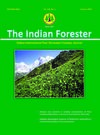Effect of Chemical Pre-Treatments on Germination and Seedling Growth in Horsfieldia glabra Warb. and Semecarpus prainii King
DOI:
https://doi.org/10.36808/if/2018/v144i1/121299Keywords:
Genetic Resources, Regeneration, Utilization, Wild Cashew, Wild Nutmeg.Abstract
The present investigation was undertaken to standardize seed germination pre-treatments in Horsfieldia glabra and Semecarpus prainii. Results revealed significant differences among the treatments for various germination related parameters in both the species. Seed treatment with GA3 (100 mg/L for 24 h) was found to be most congenial for obtaining maximum germination percentage (78.79%), lowest T50 value (27.17 d), and highest seedling collar thickness (4.02 mm) in H. glabra. Among the treatments studied, water soaking for 2 h was found to improve germination in both cultivated cashew (100.00%) and wild cashew (S. prainii, 35.52%). Interestingly, treatment of cultivated cashew seeds with acetone supported better seedling growth, while this treatment failed to induce any germination in wild cashew. Hence, seed treatment with GA3 (100 mg/L for 24 h) and water soaking for 2 h could be recommended for obtaining seedlings in large number in H. glabra and S. prainii, respectively. These findings could support habitat enrichment programmes and facilitate the conduct of systematic studies in these potential crop wild relatives.References
Butola J.S. and Badola H.K. (2004). Effect of pre-sowing treatment on seed germination and seedling vigour in Angelica glauca, a threatened medicinal herb. Curr. Sci., 87(6):796-799.
Chaichana N. (2016). Nutrition composition and analysis of medicinal herbal potential of Horsfieldia glabra Warb.seeds. KMUTNB Intl. J. Appl. Sci. Technol., 9(1):61-69.
Coolbear P., Francis A. and Grierson D. (1984). The effect of low temperature pre-sowing treatment on the germination performance and membrane integrity of artificially aged tomato seeds. J. Experimental Botany, 35(11):1609-1617.
Farooq M., Basra S.M.A., Hafeez K. and Ahmad N. (2005). Thermal hardening: a new seed vigor enhancement tool in rice. J. Integrated Plant Biol., 47:187–219.
Ford-Lloyd B.V., Markus S., Susan J.A., Oz B., Jan E., Rivka H., Karl H., Shelagh P.K., Dingming K., Korous K., Yinghui L., Chunlin L., Bao-Rong L., Keping M., Viet T.N., Lijuan Q., Song G., Wei W., Zongwen Z. and Nigel M. (2011). Crop Wild Relatives—Undervalued, Underutilized and under Threat? BioSci., 61(7):559-565.
Haldankar P.M., Khandekar R.G. and Joshi G.D. (2007). Effect of growth regulators on germination and seedling growth in nutmeg. South Indian Hort., 55:315-319.
Hassler M. (2016). World Plants: Synonymic Checklists of the Vascular Plants of the World (version May 2016). In: Species 2000 & ITIS Catalogue of Life, 28th July 2016 (Roskov Y., Abucay L., Orrell T., Nicolson D., Kunze T., Flann C., Bailly N., Kirk P., Bourgoin T., DeWalt R.E., Decock W., De Wever A., eds). Digital resource at www.catalogueoflife.org/col. Species 2000: Naturalis, Leiden, the Netherlands. ISSN 2405-8858
Khan M.R. (2015). Effects of seed treatment and storage containers on germination and storability of Semecarpus anacardium Linn. f. Seed. Bio-Sci. Res. Bull., 31(1-2): 25-32.
Krishnamoorthy B. and Rema J. (1988). Seed Propagation techniques in nutmeg. Indian Cocoa Arecanut Spices J., 12:38-39.
Krishnamurthy K.S., Rema J., Mathew P.A. and Krishnamoorthy B. (2008). Identification of suitable Myristica species/ related taxa as rootstock to combat drought in nutmeg. Indian J. Hort., 65(2):204-208.
Lobell D.B., Burke MB, Tebaldi C., Mastrandrea M.D., Falcon W.P. and Naylor R.L. (2008). Prioritizing climate change adaptation needs for food security in 2030. Sci., 319:607-610.
Mandal R.C. (2000). Cashew Production and Processing Technology. Agrobios (India) Publishers, Ludhiana. 22-31 pp.
Pandey A., Tomer A.K., Bhandari D.C. and Pareek S.K. (2008). Towards collection of wild relatives of crop plants in India. Genet. Resour. Crop Evol., 55:187–202.
Pandey R.P. and Diwakar P.G. (2008). An integrated checklist flora of Andaman and Nicobar Islands, India. J. Econ. Taxon. Bot., 32(2):403–500.
Pinto M.M.M., Anake K., Bumrung T., Massayoshi Y. and Otto R.G. (1988). Arylalkanones from Horsfieldia glabra. Phytochem., 27(12):3988-3989.
Prasad B. and Prasad R. (2009). Selection of suitable growth regulators and its concentration forbetter germination and seedling growth of Himalayan Dogwood (Benthmidia capitata Wall ex. Roxb.). Indian J. Forestry, 32(4):523-527.
Rasingam L. and Parathasarathy N. (2009). Tree species diversity and population structure across major forest formations and disturbance categories in Little Andaman Island, India. Trop. Ecol., 50(1):89-102.
Salisbury F.B. and Ross C.W. (1995). Plant Physiology, II Indian edn., CBS Publishers and Distributors, New Delhi Samir M., Rai R. and Prasad B. (2015). Seed germination behaviour as influenced by pre-sowingtreatments in khirni. J. Hill Agri., 6(1):132-135.
Sfairi Y., Ouahmane L. and Abbad A. (2012). Breaking seed dormancy in Cupressus atlantica Gaussen, an endemic and threatened coniferous tree in Morocco. J. For. Res., 23(3):385-390.
Shah S.H. (2007). Physiological effects of pre-sowing seed treatment with gibberellic acid on Nigella sativa L. Acta Botanica Croatica, 66(1):67-73.
Singh S., Waman A.A., Bohra P., Gautam R.K. and Roy S.D. (2016). Conservation and sustainable utilization of horticultural biodiversity in tropical Andaman and Nicobar Islands, India. Genet. Resour. Crop Evol., DOI 10.1007/s10722-016-0445-5
Subbaiah C.C.(1982). Effect of pre-soaking in organic solvents on seed germination and seedling growth of cashew. Sci. Hortic., 18:137-142.
Vanaja T., Neema V.P., Mammootty K.P. and Rajeshkumar R. (2008). Development of a promising interspecific hybrid in black pepper (Piper nigrum L.) for Phytophthora foot rot resistance. Euphytica, 161:437–445.
Waman A.A. and Bohra P. (2016). Sustainable development of medicinal and aromatic plants sector in India: an overview. Sci. Cult., 82(7–8): 245-250.
Downloads
Downloads
Published
How to Cite
Issue
Section
License
Unless otherwise stated, copyright or similar rights in all materials presented on the site, including graphical images, are owned by Indian Forester.





